#German Imaging Technologies
Explore tagged Tumblr posts
Text
#BestStartUpStory#DrSassanDieterKhatibShahidi#CEO#Founder#German Imaging Technologies#EcoFriendlyPrinting#ECOPLAN#SustainablePrinting#InnovativeTechnology
0 notes
Text













Musst keine Angst haben. Jeder hat mal so angefangen.
Coming Out (1989), dir. Heiner Carow
#lala takes screenshots of obscure movies because no one else will#!!!#finally#the saga continues!#queer cinema#eastern european cinema#east germany#gdr#ddr#defa#as someone put it: gdr's first and last gay movie#please do not zoom into these pictures#even filmfriend has anti screenshot technology now#so i had to first screen record the entire film with a program i managed to find that worked#and then take the screenshots#which i think didnt help the quality#anyway#a very good spectacular film#it's on filmfriend#ie you can watch it with your german library card#also this movie tore down the berlin wall by its mere presence#(it premiered in east berlin on 9 nov 89)#david hasselhoff who#jk#unless...#also i couldnt take a decision if my life depended on it#so have 13 images#i marvel at people who can narrow a film down to like... 5 pictures#film#*
35 notes
·
View notes
Text
help i read bertie describing how horrible it is to sleep in a summer house and innocently annotated it with "bertie would Hate scouting" and now i can't get bertie as a boy scout out of my head
#me with any character i like: right but what if they went to scouts camp#i dont have a very fleshed out image of bertie as a teenager though so idk#and im also not big on fic writing so thisll only live in my brain#but yeah#currently imagining him in a scouts uniform#jeeves and wooster#bertie wooster#ok this is literally just for me bc this is about german scouting groups#but i feel like bertie wouldve been in the dpsg and jeeves in the bdp#and theyd always argue about it bc jeeves is convinced that the bdp is the Only Proper Scouting and bertie would be like#You Sleep On Sheep Skins#Why Use Actual Fire Torches If You Have The Advantages Of Modern Technology#(this is anachronistic ik. i just have Opinions on the bdp)
21 notes
·
View notes
Text
What is Dataflow? Part 2: Diagrams
This is the second part of a couple of posts about Dataflow, particularly why it's important for the world going forward and relating to the Crowd Strike IT disaster.
Read the first part here.
Before I get into this one today, I wanted to address a couple of things.
Firstly, Dataflow is something that nearly every single person can understand. You do NOT:
Need to have a degree in Computing Science
Need to work in IT
Need to be a data analyst / Spreadsheet master
If any of you see the word 'Data' and feel your eyes glazing over, try and snap out of it because, if you're anything like me, Dataflow is much more approachable as a concept.
Secondly, what do I mean by IT?
Traditionally in most of our media the all-encompassing 'IT department' handles everything to do with technology. But every business works differently and there are many job titles with lots of crossover.
For example, you can be an infrastructure engineer where your focus is on building and maintaining the IT infrastructure that connects your organisation internally and externally. This is a completely different role from an Application Portfolio Manager who is tasked with looking after the Applications used in business processes.
Both are technical people and come under the banner of 'IT' - but their roles are focused in different areas. So just bear that in mind!
Now that's out of the way, let's begin! This one will be a little bit deeper, and questions welcome!
An Intro to Diagrams
You probably do not need a history of why pictures are important to the human race but to cover our bases, ever since we put traced our hands on a cave wall we have been using pictures to communicate.

Jump forward in time and you have engineers like Leonardo Da Vinci drafting engineering schematics.

You get the idea, humans have been creating diagrams (Pictures) for thousands of years. Centuries of refinement and we have much more modern variations.
And there's one main reason why diagrams are important: They are a Common Language.
In this context, a Common Language helps bridge a language gap between disciplines as well as a linguistic gap. A Spanish electrician and a German electrician should be able to refer to the same diagram and understand each other, even if they don't know each other's language.
The reason they can do this is because they're are international standards which govern how electrical diagrams are created.
A Common Language for Digital?
Here's an image I've shown to clients from governments and institutions to global organisations.

Everything around us, from the products we use to the bridges we drive over and the buildings we live, work, enjoy and shop in had diagrams backing them.
You would not build a skyscraper without a structural engineering diagram, you would not build an extension on your house if an architect couldn't produce a blueprint.
Why is there not an equivalent for the Digital World and for Dataflow?
Where is the Digital Common Language?
This is the bit where the lightbulb goes on in a lot of people's heads. Because, as I mentioned in Part 1, the flow of data is the flow of information and knowledge. And the common mistake is that people think of dataflow, and only ever think about the technology.
Dataflow is the flow of information between People, Business Processes *and* Technology Assets.
It is not reserved to Technology specialists. When you look at the flow of data, you need to understand the People (Stakeholders) at the top, the processes that they perform (and the processes which use the data) and the technology assets that support that data.
The reason why this is important is because it puts the entire organisation in context.
It is something that modern businesses fail to do. They might have flow charts and network diagrams, and these are 'alright' in specific contexts, but they fall to pieces when they lack the context of the full organisation.
For example, here is a Network Diagram. It is probably of *some* value to technical personnel who work in infrastructure. Worth bearing in mind, some organisations don't even have something like this.

To be absolutely clear, this diagram will hold some value for some people within the organisation. I'm not saying it's completely useless. But for almost everyone else, it is entirely out of context, especially for any non-technical people.
So it doesn't help non-technical people understand why all of these assets are important, and it doesn't help infrastructure teams articulate the importance of any of these assets.
What happens if one of those switches or routers fails? What's the impact on the organisation? Who is affected? The diagram above does not answer those questions.
On the other side of the business we have process diagrams (aka workflow diagrams) which look like this.

Again we run into the same problem - This is maybe useful for some people working up at the process layer, but even then it doesn't provide context for the stakeholders involved (Are there multiple people/departments involved throughout) and it doesn't provide any context for technical personnel who are responsible for maintaining the technology that supports this process.
In short, nobody has the big picture because there is not a common language between Business & IT.
Conclusion
So what do we do? Well we need to have a Common Language between Business & IT. While we need people with cross-functional knowledge, we also need a common language (or common framework) for both sides of the organisation to actually understand each other.
Otherwise you get massively siloed departments completely winging their disaster recovery strategies when things like Crowd Strike goes down.
Senior Management will be asked questions about what needs to be prioritised and they won't have answers because they aren't thinking in terms of Dataflow.
It's not just 'We need to turn on everything again' - It's a question of priorities.
Thing is, there's a relatively simple way to do it, in a way that looking at any engineering diagram feels simple but actually has had decades/centuries of thought behind it. It almost feels like complete common sense.
I'll save it for Part 3 if you're interested in me continuing and I'll make a diagram of my blog.
The important thing is mapping out all the connections and dependencies, and there's not some magic button you press that does it all.
But rigorous engineering work is exactly that, you can't fudge it with a half-arsed attempt. You need to be proactive, instead of reacting whenever disaster strikes.
380 notes
·
View notes
Text
Leviathan Panel at Otakon 2024
I was OVERJOYED to be at the Leviathan panel during Otakon 2024! I'll do my best to recap it below, but if you want a more coherent play by play, this Twitter user did an excellent job.
I've got a handful of photos, recap of Sharp Gender Discussion, plus misc. things I remember.

Not everyone was up for the entire time, but I snapped this photo near the end when everyone was on stage! From left to right: Waki Kiyotaka (Studio Orange), Yoshihiro Watanabe (Studio Orange), Scott Westerfeld, Christophe Ferreira (Quibic Pictures), Justin Leach (Quibic Pictures), Katrina Minett (Quibic Pictures), and Diana Garnet (ending theme vocalist).

New concept art! Looks like Dr. Barlow, Klopp, Alek, and Sharp, right before the Germans attack the Leviathan.
More under the cut!
Alternative shot of that art bc I couldn't get my lighting right:


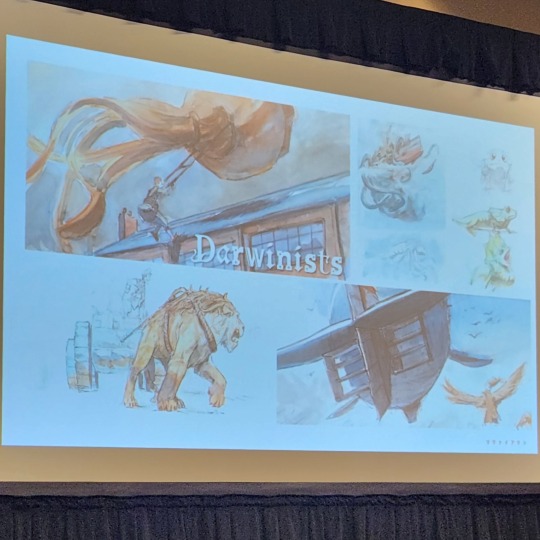
Clanker and Darwinist technology designs. Watanave explained that Studio Orange's early days were spent doing contract work on Gundam anime, so I can't wait to see how that translates to the Clanker machines.
Some more concept art:


By the way, the entire series is being adapted at once - so we'll get the complete story at once! That in mind, the second image here makes me think of that maneuver near the beginning of Goliath to pick up the cargo.

Sharp!!! Look at them!!!
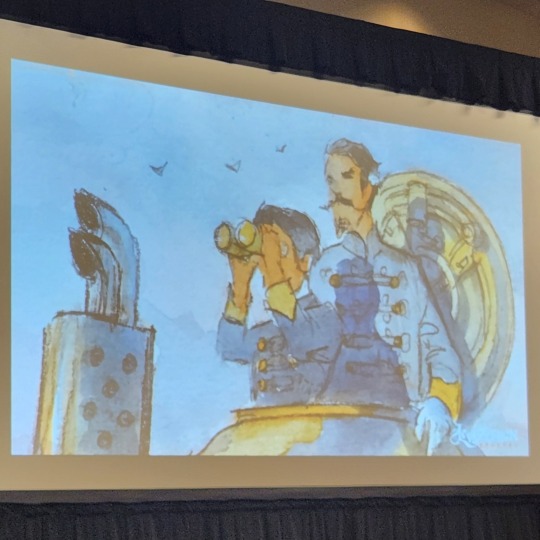

I don't have much to say about these but I'm fairly sure I hadn't seen them before. I am wondering if they downsized Alek's crew for the sake of the story, or perhaps we just haven't seem Bauer and Hoffman yet.
We got some new character art! The panel was very cryptic about who the character designer is. Apparently they're pretty well known, but they can't share it yet!

Volger I am so sorry your photo was unfocused. Forgive me.
The panel jokingly described him as "Alek's dad," which feels accurate. And maybe I misunderstood, but it sounds like he plays an even more important role in the anime than he does in the books. I've always considered Volger to be a pretty important character, so I wonder what else he'll do in this new series.
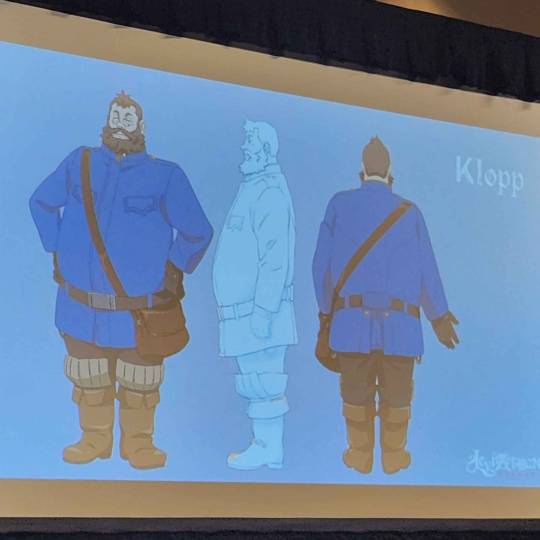
Klopp looks exactly like how I pictured him in my mind!! They said if Volger is Alek's dad, then Klopp is like his mom. Which is very fair but also made me laugh a lot.
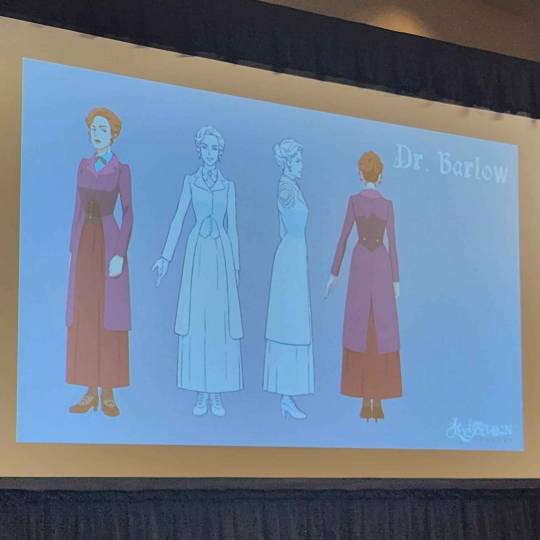
Dr. Barlow!! She looks amazing. There was a lot of talk about the dynamic between her and Volger and how they're often playing mental chess games with each other. I'm really glad they're leaning into that dynamic.
And one more concept art:
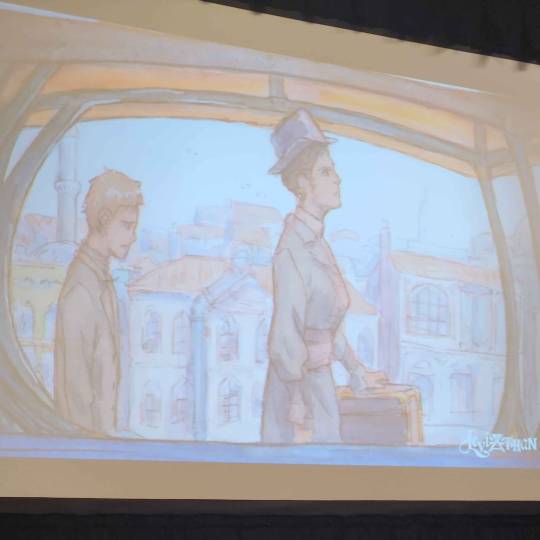
This looks like the visit to Istanbul, which I'm desperately hoping means we'll see my favorite chaotic bisexual, Lilit.
That's all of the photos I have! They also showed us a preview of the show plus a live performance of the ending song with Diana Garnet. No video recording was allowed and I don't break rules, but believe me when I tell you it was stunning. The world feels so full of life and adventure and I can't wait to see the final show.
Tbh I was too busy holding back tears of joy but one thing I remember distinctly is there's a shot of Sharp getting ready for the day, and we see a sheet of paper with a bunch of names written and crossed out before finally (I think) "Dylan" is circled.
Which actually brings me to the Q&A part. TLDR, between the use of "Sharp" for Deryn's name, Scott referring to Sharp as "she/he/they" during the panel, and the scene I mentioned earlier, I feel really hopeful about how they're approaching Deryn's gender and identity in this adaptation.
I asked a question about this at the Q&A and voice recorded it, so I'll try to transcribe it here as best I can because the audio is not great lol. I stumbled through my question so I trimmed it down here but I'll transcribe the response as clearly as I can!
Me: I just finished re-reading [the series] for the first time since I was probably in high school, and one of the things that interests me about this adaptation is the approach to Sharp's character... I guess I'm just interested, like, was there a lot of thought put behind, or what kind of thought was put behind how to approach their character in the anime, I guess as a chance to re-approach the story however many years after it was originally written.
Scott Westerfeld: Yeah, there's a lot to that. The "girl dressing as a boy" as a trope was something completely different in 2007 when I started writing this than it is now. And so we really approached Deryn's identity as what was at stake rather than just... rather than just her being in disguise, it's about their recreating themselves and becoming a different person and transitioning and, and so... but it's always been interesting to me that the words that I wrote back in 2009, 10, 11, y'know, as an old guy who grew up in Texas in the 70s - who was David Bowie fan! - but otherwise didn't have a lot of access into issues of gender, I'm amazed at how many people have been [able to?] adopt Deryn/Dylan as one of their own. I just got an email a week ago from a trans boy whose chosen name is Dylan. So it is amazing to me how whatever imperfections or whatever problematics there are in the text, people still find their way into what they need from a character. And as a writer, I can say that I always respected that character, I always respected their choices, I always respected who they were. I never tried to stick them into a dress and have everyone go "Ooh now you're pretty 'because 'cause you're in dress!" We didn't do that, and I think that what may be important for people and I think that's why it's still what's gonna work here, but it's been fun to be able to update it and everybody on the team's been really great about understanding that.
TLDR I don't want to get anyone's hopes up too high, but I'm really appreciative of the care that's being taken with Sharp's story and identity in this adaptation. It seems like Scott and the others on the team are taking that into account, and I'm excited to see how it plays out.
Other random things I remember:
THERE WAS AN ALEK COSPLAYER. I took a photo with them but I won't post it without their consent. Just trust that they looked fantastic.
Scott said one of the first things he was told was that Alek can't actually kill Nikola Tesla because he's too well loved by people in Japan, which I think is the funniest possible reason for a change to be made in an adaptation.
Diana Garnet (they/any) mentioned how much they love Sharp (don't we all) and also how they used to work at a Barnes and Noble and remembers selling lots of Westerfeld books!
Scott said his approach in writing Leviathan was taking everything he'd always wanted to write about and basically throwing it together, because he was just coming off of the success of Uglies and figured he could get away with it.
If I remember anything else I'll add on to this post! Overall, it was a wonderful panel and I'm incredibly excited for this project.
#studio orange#qubic pictures#leviathan anime#leviathan scott westerfeld#leviathan trilogy#leviathan netflix#scott westerfeld#deryn sharp#leviathan series#leviathan alek#prince alek#otakon#otakon 2024
139 notes
·
View notes
Text
The Artemis I Mission: To the Moon and Back
The Artemis I mission was the first integrated test of the Orion spacecraft, the Space Launch System (SLS) rocket, and Exploration Ground Systems at NASA’s Kennedy Space Center in Florida. We’ll use these deep space exploration systems on future Artemis missions to send astronauts to the Moon and prepare for our next giant leap: sending the first humans to Mars.
Take a visual journey through the mission, starting from launch, to lunar orbit, to splashdown.
Liftoff

The SLS rocket carrying the Orion spacecraft launched on Nov. 16, 2022, from Launch Complex 39B at NASA’s Kennedy Space Center in Florida. The world’s most powerful rocket performed with precision, meeting or exceeding all expectations during its debut launch on Artemis I.
"This is Your Moment"

Following the successful launch of Artemis I, Launch Director Charlie Blackwell-Thompson congratulates the launch team.
“The harder the climb, the better the view,” she said. “We showed the space coast tonight what a beautiful view it is.”
That's Us

On Orion’s first day of flight, a camera on the tip of one of Orion’s solar arrays captured this image of Earth.
Inside Orion

On the third day of the mission, Artemis I engineers activated the Callisto payload, a technology demonstration developed by Lockheed Martin, Amazon, and Cisco that tested a digital voice assistant and video conferencing capabilities in a deep space environment. In the image, Commander Moonikin Campos occupies the commander’s seat inside the spacecraft. The Moonikin is wearing an Orion Crew Survival System suit, the same spacesuit that Artemis astronauts will use during launch, entry, and other dynamic phases of their missions. Campos is also equipped with sensors that recorded acceleration and vibration data throughout the mission that will help NASA protect astronauts during Artemis II. The Moonikin was one of three “passengers” that flew aboard Orion. Two female-bodied model human torsos, called phantoms, were aboard. Zohar and Helga, named by the Israel Space Agency (ISA) and the German Aerospace Center (DLR) respectively, supported the Matroshka AstroRad Radiation Experiment (MARE), an experiment to provide data on radiation levels during lunar missions. Snoopy, wearing a mock orange spacesuit, also can be seen floating in the background. The character served as the zero-gravity indicator during the mission, providing a visual signifier that Orion is in space.
Far Side of the Moon

A portion of the far side of the Moon looms large in this image taken by a camera on the tip of one of Orion’s solar arrays on the sixth day of the mission.
First Close Approach

The Orion spacecraft captured some of the closest photos of the Moon from a spacecraft built for humans since the Apollo era — about 80 miles (128 km) above the lunar surface. This photo was taken using Orion’s optical navigational system, which captures black-and-white images of the Earth and Moon in different phases and distances.
Distant Retrograde Orbit

Orion entered a distant retrograde orbit around the Moon almost two weeks into the mission. The orbit is “distant” in the sense that it’s at a high altitude approximately 50,000 miles (80,467 km) from the surface of the Moon. Orion broke the record for farthest distance of a spacecraft designed to carry humans to deep space and safely return them to Earth, reaching a maximum distance of 268,563 miles (432,210 km).
Second Close Approach

On the 20th day of the mission, the spacecraft made its second and final close approach to the Moon flying 79.2 miles (127.5 km) above the lunar surface to harness the Moon’s gravity and accelerate for the journey back to Earth.
Cameras mounted on the crew module of the Orion spacecraft captured these views of the Moon’s surface before its return powered flyby burn.
Heading Home

After passing behind the far side of the Moon on Flight Day 20, Orion powered a flyby burn that lasted approximately 3 minutes and 27 seconds to head home. Shortly after the burn was complete, the Orion spacecraft captured these views of the Moon and Earth, which appears as a distant crescent.
Parachutes Deployed

Prior to entering the Earth’s atmosphere, Orion’s crew module separated from its service module, which is the propulsive powerhouse provided by ESA (European Space Agency). During re-entry, Orion endured temperatures about half as hot as the surface of the Sun at about 5,000 degrees Fahrenheit (2,760 degrees Celsius). Within about 20 minutes, Orion slowed from nearly 25,000 mph (40,236 kph) to about 20 mph (32 kph) for its parachute-assisted splashdown.
Splashdown

On Dec. 11, the Orion spacecraft splashed down in the Pacific Ocean off the coast of California after traveling 1.4 million miles (2.3 million km) over a total of 25.5 days in space. Teams are in the process of returning Orion to Kennedy Space Center in Florida. Once at Kennedy, teams will open the hatch and unload several payloads, including Commander Moonikin Campos, the space biology experiments, Snoopy, and the official flight kit. Next, the capsule and its heat shield will undergo testing and analysis over the course of several months.
Make sure to follow us on Tumblr for your regular dose of space!
#Artemis#LunarMission#SpaceLaunchSystem#Rocket#Space#MegaMoonRocket#Moon#Spacecraft#Orion#NASAMoonSnap#Moonikin#Earth#LunarOrbit#Splashdown#Launch
2K notes
·
View notes
Photo





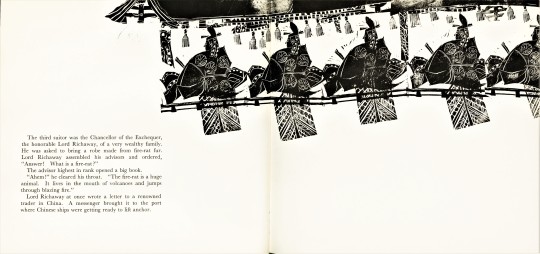
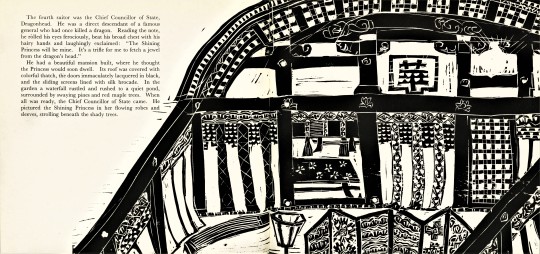



Staff Pick of the Week
My staff pick this week is the trade edition of The Tale of the Shining Princess by Japanese-born writer Hisako Matsubara (b.1935) and Japanese-Canadian artist-printmaker Naoko Matsubara (b.1937), published by Kodansha International LTD. Tokyo, Japan in 1966.
As a artist-printmaker and bookmaker who makes woodcuts, I am greatly inspired by Naoko’s prints. Naoko Matsubara’s work carries on traditions of Japanese printmaking while having its own contemporary flavor. Her woodcuts are ecstatic, they are vibrating with movement. Her use of bold shapes and the white line of the the carving tool makes the most of what woodcut has to offer. In the book form, the active images carry the reader’s eyes through the book space. Her use of negative space activates the page. Additionally, her woodcuts have translated beautifully to commercial printing.
The Matsubara sisters are daughters of a senior Shinto priest, and were raised in Kyoto. Both studied, lived, and worked in the United States. Hisako received her Master of Arts degree from Pennsylvania State College, moving to Germany where she continued her studies and became a prominent writer, publishing her work in Japanese, English, and German. In the 1980s she moved back to the United States, this time to California where she worked at Stanford University.
Naoko received her Master of Fine Arts from Carnegie Institute of Technology in Pittsburgh, now Carnegie Mellon University. After her studies she traveled across Europe and Asia. She returned to the United States and became the personal assistant to the artist and wood engraver Fritz Eichenberg, an artist who has been featured many times on our blog. Naoko taught at Pratt University in New York and at the University of Rohde Island. She also lived in Cambridge, Massachusetts for a time. Naoko is currently living and working in Canada in Oakville, Ontario, where she continues to work and exhibit nationally.
The work of both Hisako and Naoko have had great influence inside the United States and around the world. So lets celebrate their accomplishments!
This book has end sheets of mulberry paper with inclusions of Bamboo leaves, the cover is a red textured paper with a gold stamped design by Naoko.



View some of our other AAPI selections for this month.
View our other Staff Picks.
- Teddy, Special Collections Graduate Intern
#staff pick of the week#The Tale of The Shining Princess#hisako matsubara#naoko matsubara#Japanese artists#Japanese writers#Japan#AAPI Hertitage Month#Asian American and Pacific Islander Heritage Month#AAPI#canadian artists#trade edition#Matsubara#woodcuts#printmaking#color printmaking#fiction#stories#teddy
426 notes
·
View notes
Text
In the wake of the modernizing process and rising fascism in Europe, members of the Frankfurt School at the Institute for Social Research astutely observed that with the rise of modernity and mass culture, culture had become an industry in itself, taking on the characteristics of every other capitalist commodity and obeying the same rules of production. While their analysis primarily focused on modernity and cultural production in Germany, their contributions to an understanding of mass culture and its mechanisms of ideological control are highly applicable to the history of Italian fascism as well. Fascism rose in Italy well before its German counterpart, and while both were aided by the support of finance capital and the conservative elite, their success was also due to the mass appeal they were able to create. Technological changes in communication, new social relations and commodity forms, and the extension of the market into the realm of culture allowed fascism to flourish in Italy, and became highly effective means of reinforcement after the Italian Fascist party seized power. However, it was not through sheer luck that these conditions worked favorably for Mussolini. He and the Italian fascists recognized the shifting social relations that accompanied modernity and strategically used them to build their image and the new Fascist culture they envisioned. Mussolini’s efforts may not have been successful if not for the tacit support he received from foreign press, specifically that of the United States, which lauded his actions and portrayed him similarly to a celebrity. Building on the work of Theodor Adorno and Walter Benjamin, I examine how the rise of mass culture and the logic of the culture industry influenced Italian fascism and the Fascist regime’s use of propaganda.
#mine#critical theory#fascism#posting some old essays#its just a paper i wrote for class it isnt groundbreaking but i think it does kind of explain some critical theory concepts
133 notes
·
View notes
Text
Petition: establish AI regulations
EU people (but possible to sign from elsewhere in the world) please add your name to this petition for human-centric and culture-friendly AI regulation. Needs 47,000 more votes as of the time of posting. From the petition:
'Summary: In an open letter, the Authors' Rights Network (Netzwerk Autorenrechte) calls on the German government as well as the French and Italian leaders to reconsider their stance on the (non-)regulation of AI, to take a stand against the massive damaging effects of unregulated AI applications based on theft, to protect people and authors from data theft and disinformation and to reflect on values such as trust, democracy and justice.
++ Open letter on the subject of France, Germany's and Italy's position on the planned EU Artificial Intelligence Act ++
Dear Chancellor Olaf Scholz (Germany),
Dear Federal Minister of Economic Affairs and Climate Action Robert Habeck,
Dear Federal Minister for Digital and Transport Volker Wissing,
Dear President Emmanuel Macron (France),
Dear Prime Minister Giorgia Meloni (Italy):
It is with great concern that we, the members of the Netzwerk Autorenrechte which represents authors and translators in the book sector from 15 organisations in the D-A-CH region, observe Germany's, Frances and Italy's new position on the AI Act proposal. This new position runs counter to the consensus previously reached by EU Member States on the legal regulation of AI, in particular with regard to transparency and liability obligations for developers of generative technology.
According to reports from Euractiv on 19 November 2023, Germany – under the lead of the Digital Ministry and the Federal Ministry for Economic Affairs and Climate Action, and together with France and Italy – wants to push for "obligatory self-regulation" instead of legally binding regulation. There are no sanctions for saftey incidents such as copyright, authors’ rights and data protection violations, insufficient labeling, or circumventing ethical standards in the position of these three countries.
Reason
Dear Chancellor, dear Vice Chancellor, dear Federal Minister,
dear Mr President of France, dear Prime Minister of Italy:
We urge you to change your position, which currently favors supposed economic advantages to the detriment of sustainable legal rules. Your position sends a fatal signal to everyone in the cultural sectors and to all people in Europe: namely, that you're willing to protect the same tech companies that illegitimately make use of cultural works and citizens data for their own profits – rather than protecting the people whose work and private data have made these foundation models and generative applications possible in the first place.
The consequences of your position would be devastating. Generative technology is already threatening numerous jobs. We can already observe several harmful “business models��� based on AI products and an increase in disinformation. It's been proven that generative AI uses unlawfully obtained works without the knowledge or consent of the works' authors. Without legal regulation, generative technologies will accelerate the theft of artistic work and data. They'll increase discrimination and the falsification of information, including damage to reputations. And they'll significantly contribute to climate change. The more legally deregulated generative products reach the market, the more irreparable the loss of trust in texts, images, and information will become for society as a whole.
We urge you to return to the values of trust, democracy, and justice. We're standing on the threshold of an evolution, of one of the most decisive moments in history. Will we regulate the machines that are using humans in order to replace them? Or will we choose the short-sighted ideology of money?
We trust you have the political resolve to do the right thing.
Berlin, 24 November 2023'
132 notes
·
View notes
Note
Do you think that people who invent things with very destructive consequences are blinded to the downsides of it more by money or more by scientific curiosity?
I think the downsides are not always immediately obvious. Coal-fired electricity looks a lot more attractive in 1882 when there's literally only one such power plant and the global population is like 18% its present value. TNT was invented as a yellow dye, and it's so stable its usefulness as an explosive wasn't discovered until thirty years later.
We have this collective mental image, promoted by simplifications of historical narratives, that the inventor is a lone genius who through his labor produces an artifact and all its consequences in a single moment in time, and without which the thing would never be invented. Pretty much every point in that narrative is wrong. New technologies are the culmination of many different discoveries; there are enough very smart people working at the cutting edge of these fields that if one of them did not discover the principles behind these inventions, another almost certainly would sooner or later; and the exact applications of new technologies, nevermind how they will change society when those applications are utilized, often take years or decades to discover.
Now, I think there is an extent to which, as a working scientists, you can reasonably be held to account for the work you do. If you work at the Acme National Horrible Death By Chemical Weapons Laboratory, and invent a new, horrible chemical weapon, you do not get to go "oh no!" in shock when somebody dies to your horrible chemical weapon. And sometimes scientists do have a pretty good idea of how their technology will be used--the Haber Process was originally invented to manufacture fertilizers, but its application to the manufacturing of explosives was pretty clear to Fritz Haber, and he joined the German effort to develop deadlier chemical weapons pretty enthusiastically.
Men like Haber seem historically to be motivated not by intrinsic greed, but by the things which motivate us all: the desire to provide for their loved ones, the approval of their peers and the respect of their colleagues, and their status in society. The problem with respect to scientists who know damn well what they're doing isn't that everybody working at the Acme National Horrible Death By Chemical Weapons Laboratory is greedy and the job pays too much; the problem is that society, by and large, respects you and looks up to you and fetes you at public events and talks about what a patriot and a community leader you are if you do really well at inventing new, horrible chemical weapons.
#i knew a guy in university who said he would have no problem working for weapons r&d#because it's not the designers of the weapons who decide how they're used#and there was a valid point there:#shaking your finger at fritz haber only absolves the german general staff of the decision to use the weapon#or the kaiser of the decision to wage war#of all the people involved in the chain of events leading to chlorine gas in the trenches of the western front#fritz haber was probably the most generic#in the sense that if you went back in time and killed him in 1915 probably nothing significant would change#i think it's a little too pat to say the person designing the horrible chemical weapon has *no* responsibility#i certainly would find the idea of trying to figure out new ways to kill people extremely morally unpleasant#but without the military and political will to use those weapons#they just sit on shelves until they stop working
295 notes
·
View notes
Photo
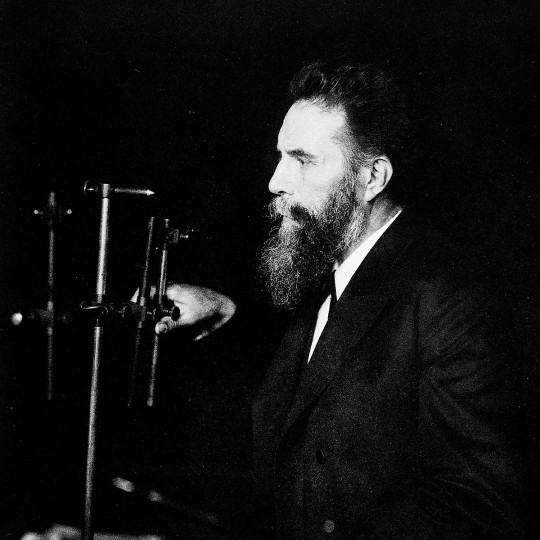
Discovery of X-Rays
The discovery of X-rays – a form of invisible radiation that can pass through objects, including human tissue – revolutionised science and medicine in the late 19th century. Wilhelm Conrad Röntgen (1845-1923), a German scientist, discovered X-rays or Röntgen rays in November 1895. He was awarded the first Nobel Prize for Physics for this discovery in 1901.
The thrill of the discovery became caught up in the late Victorian obsession with ghosts and photography. X-rays could 'photograph' the invisible, penetrating flesh, exposing bones and the human skeleton. 'Bone portraits' became popular, and photographers opened studios for a public fascinated by otherworldly images of skeletons.
Wilhelm Conrad Röntgen
Wellcome Collection (CC BY)
One of the first medical uses of X-rays occurred in 1896 when John Francis Hall-Edwards (1858-1926), a British doctor, located a needle embedded in a colleague's hand. X-ray technology soon moved from being seen as a new form of photography to a modern diagnostic tool used by hospitals and medical practitioners.
Wilhelm Conrad Röntgen was a meticulous scientist, but the discovery of X-rays may have been an unintentional result of his work with cathode rays in his Würzburg laboratory in Bavaria, Germany.
Early Years
Wilhelm Conrad Röntgen was born in Lennep, Prussia (Remscheid-Lennep, Germany) on 27 March 1845, to a German textile merchant father and a Dutch mother. He was an only child and spent his early years in Apeldoorn in the Netherlands. His father, Friedrich Conrad Röntgen (1801-1884), managed a cloth manufacturing business in Apeldoorn. The family had also moved due to political unrest in Prussia.
Röntgen attended the Utrecht Technical School from 1861 to 1863 but was expelled when a fellow student drew a caricature of a teacher. Röntgen was implicated but refused to name the student responsible. Despite excellent marks, he did not graduate with a technical diploma and could not obtain a degree in the Netherlands. He was accepted by the Mechanical Technical Division of the Federal Polytechnic School in Switzerland in 1865, where he gained a diploma in mechanical engineering and, in 1869, a PhD in physics with his thesis Studies on Gases.
The German experimental physicist August Kundt (1839-1894) was Röntgen's supervisor. In 1866, Kundt designed the Kundt Tube, a glass apparatus that measured the speed of sound in gases. Kundt significantly influenced Röntgen and his research career.
Röntgen followed Kundt to the University of Würzburg in 1870, where he worked as an unpaid assistant during a time of rapid advancements in experimental physics. Scottish mathematician James Clerk Maxwell (1831-1879) was researching electromagnetic radiation and established the connection between light and electromagnetic radiation. Maxwell also took the first colour photograph in 1861, based on his three-colour theory that the human eye sees colour through a combination of blue, red, and green light. Massachusetts-born Samuel Morse (1791-1872) developed the electric telegraph, which transmitted messages over long distances, and Morse code to encode messages, while Alexander Graham Bell (1847-1922) invented the telephone.
Of particular interest to Röntgen was the work of German physicist Heinrich Hertz (1857-1894) and British chemist William Crookes (1832-1919). Both scientists studied cathode rays – invisible streams of electrons whose behaviour can be observed when an electrical current is passed between the two electrodes (cathode and anode) in a glass vacuum tube. It is called a cathode ray because the electrons are emitted from the cathode (or negative electrode) when an electrical current heats it, and the electron stream glows. Johann Wilhelm Hittorf (1824-1914) was the first to detect cathode rays glowing green in the glass wall of a vacuum tube in 1869 but did not realise that X-rays had been produced during his experiments.
Röntgen became fascinated with the fluorescence caused by cathode rays hitting certain materials, such as salts like barium platinocyanide, which glow a greenish-yellow colour when exposed to cathode rays. It was this fascination that led to the discovery of X-rays.
Continue reading...
29 notes
·
View notes
Note
I've thinking about this question… and I want to know your perspective:
At first I though British tabloids were kind of invasive and intrusive, I know Diana died in Paris, but somehow I attached it to the British media…
since this year, i´m not sure after what happened with Frederick and that woman, and how some media behave with Catherine (except for TMZ)... I´m not sure which media (Country) is more intrusive.
Given on your experience, which media/tabloide is worse that others?
You can't actually compare the media and tabloid culture that way. Or at least, I'm not comfortable comparing the cultures in that way because it leads to a really flawed analysis.
First, the tabloid culture of the '90s (which affected Diana) was incredibly different from the tabloid culture of the '00s (Kate) and incredibly different from the tabloid culture of today ('20s).
Second, the cultures between the different countries and their media enterprises is also incredibly different. What American media does isn't what British media does, which isn't what Spanish media does, which isn't what Italian or German or French media does.
In both respects, there's no established baseline standard of practice. And you need a baseline in order to set the scale to define what you mean by "worse." Because all of the examples anon cited are from very different times and from different countries, you can't really compare them to each other. So you really can't compare what Frederick went through media-wise with his affair in 2023 in Spain to what Diana went through in 1997 in France to what Kate went through in 2008 in England to what Meghan went through in 2016 in Canada. (And then you have to account for bias and familiarity; most of us only know the tabloid and media culture in the countries that we grew up in or that we're knowledgeable of. For instance, i know a lot about American tabloid culture because I'm an American and because I came of age on Perez Hilton's internet and I know quite a bit about British tabloid culture because of how long I've been a royal watcher. But I know next to nothing about tabloid culture from the '80s - beyond what I've seen in documentaries - or media from other countries.)
What can really only happen is looking within - e.g., if you look at just the tabloid culture of the '90s or of the '10s, or if you look at just the media in England or in Spain. But again, that requires even knowledge of all the countries and all the media/tabloids, rather than just the ones that you know really well.
I know this probably isn't the analysis or the answer that you were looking for, anon.
Focusing specifically on my own personal knowledge of British and American media and tabloid culture, my theory is that British tabloids and media were more viscious in the '90s. They were checked by the public after Diana's death when the backlash against mass consumption reached fever pitch with the likes of George Clooney and Tom Cruise laying the blame for her death specifically on consumers and paparazzi. So while the British tabloids were licking their wounds and trying to find a new star/celebrity to replace Diana (JFK Jr. worked for a bit but then he died), American media and tabloid culture grabbed ahold of the reigns and became the mean, viscious ones in the '00s by turning their coverage on the young female stars of Millennial Hollywood and being more critically- and gossipy-focused in their coverage. American media continued to be the meaner, viscious, "worse" ones until the mid-'10s, when the rise of social media checked them because social media, or Web 2.0 technologies/user-generated content, meant the famous people could control their own image through their own specifically and specially curated content. This is when we started to see the celebrities partnering with tabloids and paparazzi take prevalence (as opposed to the spontaneous stakeouts of known celeb hotspots) and that's where tabloid culture in the US and the UK is today - it's a partnership between the famous person and the publication or photographer.
I can't comment on Spanish media or how the tabloids contributed to Frederick's affair(s) because I know nothing about Spanish media, Danish media, and the Danish royal family.
19 notes
·
View notes
Text





article from the english edition of the Hankyoreh, Sept 10 2024
archive link
plain text:
Pavel Durov, the founder and CEO of the chat app Telegram, who has been indicted without arrest for aiding and abetting the proliferation of child sexual abuse material on his platform, is trying to calm the storm by announcing the removal of various controversial features from Telegram. However, his response is getting slammed for its shallowness, as such wishy-washy measures cannot stop the barrage of illegal pornography proliferating on the platform.
On Friday, Durov posted on his X (formerly known as Twitter) account to say that Telegram has “removed the People Nearby feature,” as well as disabled “new media uploads to Telegraph, [Telegram’s] standalone blogging tool.”
“While 99.999% of Telegram users have nothing to do with crime, the 0.001% involved in illicit activities create a bad image for the entire platform, putting the interests of our almost billion users at risk,” Durov claimed.
While Telegram has agreed to delete two features that have been used for criminal purposes, these features are largely unrelated to the recent sex crimes involving deepfakes. The “people nearby” feature utilizes GPS technology to track your phone’s location and indicate other users in the area, allowing people to form chat rooms with people in their region.

Telegram logo. (Reuters/Yonhap)
This feature shares a user’s location data without their consent and places users at risk of stalking. Critics pointed out that it has often been used by bot programs to indiscriminately target people for financial scams. The Telegraph feature allows users to anonymously upload blog posts, photos and videos. Scammers would use this feature to create fake websites, share the links to the fake sites, and lure unsuspecting users into phishing scams that harvested their personal data. Yet neither of these features is directly related to the production and distribution of illicit deepfakes.
Experts say that simply removing one feature is not going to uproot digital sex crimes. Malicious users constantly create and discover ways to circumvent such controls or restrictions or simply migrate to more liberal platforms, where they can replicate their crimes.
Cho Gyeong-suk, an activist with IT feminist group Techfemi who identifies and reports bots that produce sexually exploitative deepfakes, explained the concept of bots sharing bots.
“If Telegram shuts down a specific bot, malicious users rapidly create a similar bot. Then they use a bot for sharing a link to that bot to repeat their crimes,” she said.
On Sept. 3, Cho discovered and reported a Telegram channel with 210,000 subscribers. Upon entering, the user is greeted with the message “We're always here. Come back to our new bot,” alongside a link to a new bot and instructions on how to use link-sharing bots in Korean, Japanese, German and French.

A message in a Telegram chat room on Sept. 3, 2024, informing readers of the address of a new deepfake sexual abuse material bot with messages in multiple languages. (courtesy of Cho Gyeong-suk)
It’s urgent to send a message to these malicious users that if they commit a crime, they will get caught.
“Telegram has agreed to cooperate with Korean authorities, but all they’ve done is share an email address,” said Park Ji-hyun, the former interim leader of the Democratic Party. Operating under a group codenamed Team Flame, Park helped expose the criminal activity of the notorious Nth Room channel.
“If the police or the KCSC [Korea Communications Standards Commission] have to find every individual video and which channel it’s in and report them all to an email address with an erasure request, it’s going to take too long for them to delete them. During that time, the videos are distributed through other channels,” Park added.
“When authorities receive a report about the distribution of illicit online sexual exploitation, an investigative body needs to be aggressively informed about the perpetrators’ IP addresses, online registration data and other identification data. We need to send a clear message to the perpetrators: You will get caught. That’s the only way they’ll stop,” she said.
“Rather than simply deleting specific features, Telegram needs to monitor its platform to prevent the distribution of child sexual abuse material or sexual content depicting minors and establish an ethical monitoring committee, like Google does. They need to discuss ways to find out what happens on their platform and to cooperate with the authorities,” said Won Eun-ji, the other half of Team Flame.
“We also need technological measures such as the automated deletion of content that shows signs of being illicit or sexually exploitative. There could also be preventative tools that prevent such content from being uploaded in the first place,” she added.
By Chung In-seon, staff reporter
12 notes
·
View notes
Text
hetalia: my hc on nations and personalities
...beyond the stereotypes!
okay okay hear me out okay hc brainrot midnight time im jacked on caffeine and the night is young aight
so lets get this straight: so first off i imagine the nations are like 96% "stereotypes of ttheir nation" (e.g. the more people think or are americans that digest too many burgers, to more likely it is America himself eats attrocious amounts of burgers. The more people say Germans are swrious, the more likely Germany is a serious dude. etc. the normal stuff we all know off.)
but the other 4%? That's the nation's "person" side, seperate from their "nation" side. It varies a little depending on country ofc but that's prob the average.
E.g. hungary and austria "divorced" but they clearly care for each other. They can't be together for literal reasons but the non-nations parts of them wouldn't mind at all.
prussia is knwon aa a great warrior so that's what he is. But his non-nation half has self doubts and the need to keep an eye on his family. Like llease, Prussia how did you know what Austria wears and eats??? I get a feeling this wasn't in the mdidle of WW2, probabky right before if i had to geuss. Austria wouldn't have moved in with Germany and by exention aprussia yet....and he waa following the dude....prussia is an overprotective helicopter parent of an older brother, canon.
France and his distaste for technology. Exhibit A: french music was consistantly the one doing the weird innovative stuff in my music history class when it wasn't Schoenberg. Besides that, i could see France not liking tech as much due to being literally a thousand. Heck, i'm pretty sure half the old nations are a bit iffy about it just because "wdym now i can't just didappear lff the grid without anyone getting cocnerned and i need passports and phones and shit?" Except maybe Denmark, China, and Japan. Those three are 100% ipad kids in old men bodies.
iceland oozes gen z. enough said. The man might be obsessed with finding tourists and his northern lights and his weird museums but the thing where his beothers are throwing plates at his door and he's like "hell noooo"? The one where he's going off to make friends over ding-dong soup with the ASEAN dudes? That's allll Iceland, the person. Far as i could find there os no iceland-malaysia embassy and closest it got was relations with indonesia. (I highly recommend checking out the iceland-diplomatics-relations wiki page. There's a very interesting factoid under the list for Asian countries i think many of you will be interested in.....but per my own doctrine, this is a Hetalia hc post and not a Politica post.)
america and his animals. That goes for estonia too. Americans are no adopting whales and aliens as pets (well maybe the donate-and-save-an-animal program but we aint keep them in the house) and i doubt estonians keep talking mochi they found randomly in a disty corner. I'm fairly certain most Eatonians don't hell "latviaaaaaa!!!!" When things go wrong either.
austria getting lost is just a him thing. That's not normal for austrians, music part is very much influenced by his people. His preference to chopin might be him though since Salzburg is in Austria and that's Mozartland. Also, Chopin is Polish.
I won't even start with the clusterfuck called Russia but Japan daydreaming about Switzerland? Yeah that was Japan's non-nation side getting really weird. Japan understandably was just as confused himswlf considering for the most part he has no prpblems being a "stereotypical japanese dude".
need i mention Italy, who has a huge crush on Germany m/hre despite him literally changing in basically everything (because that's the natire of a nation), and just likes the guy as long as he exists?
I also choose to believe Sweden can grow a beard if he really followed the stereotype (no seriously. Why os the image i get of Sweedish guys just dudes with beards? Someone has a really nice sweden somewhere ln this site where he has a lovely beard and it just makes him look like the embodiment of sweeden, no questions asked). But he doesn't like it, which fair o imagine beards aren't fun when stiff gets stick in them or whatever, so he just shaves or leaves some stubble. Def not cuz Asians and beards is just not really a thing so Hima prob just didn't draw beyond the stubble.
Latvia being a secret brainiac that plays mental chess against himself while doing other stuff, all hidden under an alcoholic who can't get rid of his past. Pretty sure his blabbermouth thie is his own personality. I did see somewhere that there's a steretype that Latvians have six toes and i kinda wanna just believe Latvia got that one too cuz why not!
theres others im sure but yeah. Those are the knes i came up with and im gonna sleep now bye lmk what you think
20 notes
·
View notes
Text
So, there's many of you now. I know we're in the How Sweet It Is Not To Know Follower Counts website and I do cherish that, but still, more people than ever in my life clicked a button that in some capacity says "I care what this dork has to tell me" and I want to acknowledge and celebrate that - especially now that this growth seems to have settled into its rhythm.

Spot when @identifying-cars-in-posts reblogged my pinned, lol.
So, for my 100th post, I felt like celebrating our love for reaching round numbers. And little in the automotive world represents it more iconically than what reigned supreme above all cars in the 1980s.
Porsche started out as an engineering firm, whose most notable contract was what would become known as the Volkswagen Beetle (and boy what a story that is). The first car of its own was the 356 seen below - a sporty body laid over Beetle underpinnings and thus still mostly made by Volkswagen. But by God, they were going to run with that recipe and perfect it 'til the sun burst.

Meanwhile, in England, a chap called Colin Chapman decides the next of his company's track cars will actually be drivable on the street, to need no trailer to go race. Thus the Lotus Seven is born and sold in kit, which avoids high taxes on the exporting of cars to the US (but those taxes would have remained had they been sold with assembly manuals… so they were sold with disassembly manuals for you to read backwards. No, seriously.).
The Porsche 356 kept getting less and less Volkswagen and more and more Porsche until in 1964, the year of the Beatles, the year of the Stones, the stone-age Beetle was left behind for good with the Porsche 911 (seen below), a blank-canvas take on the same recipe of an air-cooled rear boxer engine powering the rear wheels of a squished-Beetle-shaped sportscar. 'Twas good.

In 1973, Lotus was doing pretty well for itself. The Seven's whole 2500 sales had carried it through producing a number of other models, and a few were even in production concurrently - a lineup! Exciting stuff! Well, that and an F1 team so successful its Wikipedia page features the section "Domination in the 60s and '70s". The exciting opportunity to move upmarket, with bigger models with AC and automatics and all that bougie shit, pushed them to move away from the image of scruffy old kit car makers, ceding the Seven's production to the last two dealers that sold it, main one being Caterham Cars.
The 911 headed into the 80s old enough to drive, and Porsche's plans considered it at the end of the line, with staff already mourning it. But then the yankee at his third week as CEO saw those plans (which to Germans are basically scripture), said "to hell with that" and extended that line off the chart. Literally. He went to the lead engineer's office and physically took a marker at a development chart. They all secretly liked that.

Still, it was clear the game was changing - intercoolers, all wheel drive, active suspension... how hard could the 911 layout go if it didn't stick to its simple air-cooled roots? Well, Porsche resolved to find out by filling it with the cusp of automotive advancements and then some. And I do mean filling - a chassis that didn't even need space for a radiator was suddenly tasked with storing it, two turbos, two intercoolers, and a good half dozen oil pumps.

Yeah good luck with that, buddy. Oh, and materials? The body was kevlar, the frame was aluminium, the floor was Nomex (ever even heard of Nomex???), the wheels were magnesium and the spokes were hollow!!!! You could blow into the spokes!!! And don't get me started on the technology! Variable height, an all-wheel-drive system that distributed torque at will, electronics galore... As you may be able to guess, development was… complex.

At one point a test driver was doing 180km/h (112mph) to go get the car un-on-fire-d, and that's just one of the plenty horror stories. Hell, work started in 1983 to create a car for Group B and took so long that when said rally series died in 1986, production was just starting. Not that development would stop at the start of production, either - the first cars just got updated when the owners took them in for their service. (Can't blame them, I fix wording in weeks-old posts...) But however long it took, the resulting Porsche 959 answered the originating question "How hard can this chassis go?" with a resounding "Hard and then some".


It was comfortable and refined enough to be driven every day, but so capable it extended the limits of the concept of production car. Put it this way: it reached car people's favorite round number, 100km/h (to yankee doodles, 60mph) in 3.6 seconds. The second fastest production car did so in 4.6. That's one second of margin in a race that ends in five. Oh, and if you want to put it another way: the 959 was the first production car to ever surpass 300km/h, let alone come 1 shy of the mythical 200mph (322km/h).
Meanwhile, the handful of chaps at Caterham was still producing the Caterham Seven. It's the Lotus Seven (specifically the third revision, from 1968), but I guess in '83 the engine changed. We were saying?
They couldn't sell the 959 stateside for lack of crash test data, and America's ban on importing foreign cars under 25 years of age had no exception. That is, until Bill Gates wanted a 959 so bad he spent 13 years getting an exception passed. That's how hot this car is.
And yet, this record-breaking, boundary-pushing, master-of-all-trades hypercar sits atop the 80s automotive landscape engulfed in shadow. But how? Why? Because it failed to contend with the greatest automotive headache: humans. It was planted, practical, reliable, predictable - docile, domesticated, amicable. Perfect. But these are not meant to be cars, they're meant to be posters. And you don't get posters of what is perfect, but of what excites you. And what excites us is the visceral, the raw, the uncompromising - the wild, the feral, the dangerous. And, of course, reaching round numbers. What excites us is a lot more like the first production car to break 200mph, the Ferrari F40.


Remember how the 959 was being developed for Group B racing and then the series died? Well, Ferrari got screwed over too, with the 288 GTO Evoluzione they were developing (seen here to the right of the base 288 GTO) suddenly having no reason to be.


The lead engineer then asked Enzo Ferrari to let him turn that weekend project (literally, they couldn't spend work week time on it) into a road car to celebrate their 40 years. Enzo, nearing the end of his days, thought "Ah, what the hell, let's leave with a bang", so they set off to build what would become the anti-959. Not anti as in response, but as in antithesis. Where the 959 was an attempt to modernize the noisy, unrefined, old-school 911 -to make a supercar "tested for everyday usability to the most strenuous standards", by Porsche's words- the F40 was a reaction to, per Ferrari's words, "customers saying Ferraris were becoming too plush and comfortable": "nothing but sheer performance. Not a laboratory for the future, as the 959 is. Not Star Wars."
To exemplify: left is the 959 - note the leather and electric seats, right is the F40, note the string you open the door with.


The F40 was noisy, crashy, torrid, and the turbo lag painstakingly smoothed out in the 959 here kicked you in the back like a locked door. It would rip your head off the moment it sensed you didn't know what you were doing. But it was more exciting - to look at, to hear, to drive. And that's what won people over - including the buyers, which were near four times as many as Porsche's despite the price tag being double.
Had the 959 lost then? Well, not quite. Enter the 959 S. Doing away with much of the 959's luxuries, like adjustable suspension, electric windows, AC, central locking, and even backsea- wait, the 959 had BACKSEATS???? Holy FUCK why does no one talk about that??? Take the family on a trip to 300kphville! I was saying. They schlapped some bigger turbos on too and power went from 444hp right past the F40's 470hp to a healthy 508, that propelled it over what any roadgoing F40 ever managed at 211mph, or 339km/h. Presumably for bragging rights.
And I want to stress, these were titans clashing here. This was leagues beyond what other production cars could even comprehend. Again, the 959 hit 100km/h in 3.6 seconds. The F40 held a record by taking less than 16 seconds to go from 0 to 160km/h(100mph) and back to 0. This was witnessing superhumans fighting through the clouds.
And then in 1992, the two chaps that 'developed' Caterhams (i.e. banged new ones together in the shed) told the chap they worked for "Hey, let's make one that's really barebones and fast", rang up their ol' mate (and ex-F1 racer) Jonathan Palmer to ask to lend a hand, and bought some of the 250hp engine that powered the Vauxhall (British for Opel) Cavalier GSi in the British Touring Car Championship.

Thus, the Caterham Seven Jonathan Palmer Evolution - a raw, uncomfortable, uncompromising beast that went fast as all fuck. Now, if you don't know Sevens you may think "Ah, so just like the F40, what with its handcrank windows and the string to open the doorlatch and all". And to illustrate how far off that is: in the Seven the windows were sown on and you latched the door yourself with a press button.

And that's the standard version which had windows and doors. The JPE didn't.

The JPE had a carbon tub you were meant to call a seat, the controls, a rev counter and a tach that didn't even bother reading until 30mph, and fuck you. And this one is not even as barebones as the JPE got: this one is painted.
So while the F40 went from 1,250kg (2760lb) to 1370kg (3020lb) when adjusted to comply with US regulations and the 959 went from 1450kg (3200lb) to the lightweight S version's 1350kg (2975lb), the Seven JPE weighed 1170. As in 1170lb. 530kg. Read that again if you need to, but it had about half the power of those two and considerably less than half the car to move. And so, in January 1993, this thing -this '50s coffin with a Vauxhall engine banged together by one guy in a shed- took the Guinness World Record for fastest car to 100km/h with a time of 3.46 seconds - and the 0-160km/h-0 record with 13.1 seconds. Close your eyes and picture that.
Yet the Seven JPE is hardly known to anyone but the most hardcore of enthusiasts, and owned by barely four dozens of 'em. So did it, perhaps, ultimately lose? Not at all. In fact, none of these cars did.
Every 959 cost Porsche twice what they sold it for, but the project proved the 911's layout could stand the test of time, and its development gave Porsche technologies it gradually infused into the 911 keeping it relevant, competitive, and most importantly alive to this day.

And I think we can safely say that when Enzo Ferrari died in 1988, a year after the F40's launch, his wish to leave with a bang was perfectly fulfilled - so much so that the F40 is commonly regarded as the peak of his legacy.
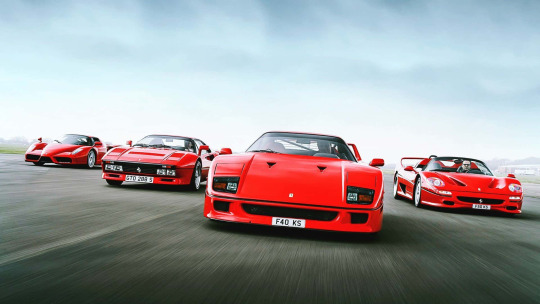
And the JPE was simply the greatest Seven ever - the most raw, thrilling, pure automotive experience the streets had ever witnessed. If driving a fast car was like biking down a hill, the Seven JPE was skydiving. Hell, it was the cover car of éX-Driver, an anime about a team using old-school sportscars to rescue haywire autonomous vehicles!


Not that culturally relevant but MAN was it cool as a kid. I need to hang those damn posters one of these days. I was saying.
These are three success stories in three radically different ways. Because, as much as I've made this post all about the numbers, sometimes it's not about that. Sometimes it's about making a show, leaving a mark, being spectacular. Sometimes it's about pushing yourself to achievements you can take pride and inspiration from. Sometimes it's simply about having fun seeing just how far you can really go. Sometimes it's about deciding what you want to be and make a new favorite version of yourself, that is the best it can be at what you care the most about. And for some that may result in less popularity or success or impact or legacy than others, but those are just some of the things you can work towards. It can be okay to just work towards having a blast. Hell, those madmen at Caterham used to stay after work to build themselves track cars, race them the next day and put ‘em back in the workshop after racing them, and the company survived to this day. Because, yes, they're still around - and their new lineup topper gets to 100 in 2.8. Windshield still optional. Well, at least there's headrests now. And a wider version, for the concrete possibility that you physically don't fit.

Never change, Caterham, because you certainly never have.
Links in blue are posts of mine explaining the words in question - if you liked this post, you might like those!
#this was meant to also celebrate 300 followers#i am just that slow at writing stuff#porsche 356#porsche 911#porsche 959 s#ferrari 288 evoluzione#ferrari f40#lotus seven#caterham seven jpe#vauxhall cavalier gsi#round numbers
45 notes
·
View notes
Text

!! CHARACTER REDESIGN & ANNOUNCEMENT POST!! character description below if you can't read the image - ⚜️ everything takes place in a pseudo-rococo era for these little sea creatures. they have technology, it's just that it looks different from ours. TATER TOT ADELLUM ⚜️👑
regent princess (ruling in place of her father)
ruler of the astroconfetti empire (a large space empire)
is made of cake. a walking cake girl.
teases tobias often
he's like eye candy for her
doesn't talk all that much... she only speaks when she has to or has something to say.
has a pet clam named hubert
knows tobias has an accent, but for some reason can't get him to talk in it
yes she has a thing for southern men TOBIAS JOE ⚜️
tater's attendant
former farm boy!
southern at heart but is trying so hard to erase that part of him
has a hillbilly family but doesn't want to talk about it
kind of ashamed of his accent, so he tries to hide it.
bro can't tell if tater's flirting with him or not and is too scared to ask DELPHINE DUPONT ⚜️
tater's most trusted advisor
french adjacent, also a cakeling like tater tot
tater's best friend, but she has *no problem* telling tater the truth, even if it's harsh.
more serious about her work than literally anyone on this list
the niece of a multi-billionaire, but she didn't get her position out of nepotism. delphine climbed her way up by proving that she is actually cut out for the job, and it took *years* to do so.
jakob's cousin! but they grew up like siblings
def suspects there's something going on between tater tot and tobias, but doesn't have proof enough to say anything.
JAKOB MONICRIEFFE 🍰
head of the financial department
son of a multi-billionaire, but got his position similarly to the way that delphine did.
earthling, not a cakeling
he's the life of the party!
he's pretty charismatic, but he can get his work done.
usually the one to convince delphine to do something fun
well-spoken & educated
bro can debate like no other. he's a champion
delphine's cousin!
he has a vague interest in tater tot. he may or may not pursue her
DIANE (LORELEI) KUZNETOV 🍰
Tater tot's secretary
she's the person a lot of people have a crush on in the office
smells like expensive candles & perfumes (dior's her favorite)
seems like a chill person
pretty kind and sweet
has goblin tendencies when no one's looking
working as a secretary as she's going to school to become a scientist!
specifically, she wants to become an astronomer. which is why she's gaining some experience working under alien leadership right now.
dating leon; it's a serious but slow burn relationship.
13th child out of 14 children
similarly to tobias, she has a weird relationship with her family
the only people in her family she has a good relationship with is her little sister and the eldest brother. (maybe i'll extend this post later to introduce them. I'll probably do that when I start introducing secondary characters)
LEON FAUST 🍰
head librarian...
he likes to keep to himself
doesn't really like jakob, thinks he's annoying
doesn't like tobias either, he thinks he's an idiot. but he can stand being around him.
thinks tater tot is ditzy (and he's kind of right)
respects delphine, but doesn't want to be friends with her.
can actually speak german!
he doesn't like anyone but diane
no siblings BOOOO
dating diane, and hopes he can marry her someday
is a really good cook (which is awesome because diane's a terrible cook)
he only cooks her and himself
as you've probably guessed by now, he's very introverted
⚜️-✨👑✨-⚜️
#digital art#oc artist#oc artwork#oc drawing#digital artist#digital artwork#digital arwork#digital drawing#answermetatertot#artist on tumblr#silly doodles#doodle#my artwork#my art#oc comic#ocs#oc art#my oc art#oc#my ocs#original character#artists on tumblr#drawing#oc intro#oc backstory#oc headcanons#my characters#oc info#my original characters
13 notes
·
View notes